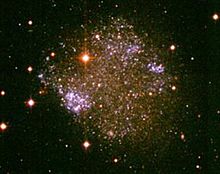Local Group


The Local Group is the group of galaxies that includes our galaxy, the Milky Way.
The group has more than 50 galaxies (including dwarf galaxies). Its center of mass is somewhere between the Milky Way and the Andromeda galaxy. The galaxies of the Local Group cover a 10 million light-year diameter and have a binary (dumbbell) shape. The group has a total mass of about (1.29 ± 0.14)×1012Ms.[1] The group itself is part of the Virgo Supercluster (also called the Local Supercluster).[2]
History
[change | change source]The term "Local Group" was introduced by Edwin Hubble in 1936.[3] He describes it as "a typical small group of nebulae which is isolated in the general field". He listed the galaxies, by decreasing luminosity, as the Andromeda galaxy, the Milky Way, Triangulum galaxy, the Large Magellanic Cloud, the Small Magellanic Cloud and half-a-dozen others.
By 2003, the number of known Local Group members has increased from his initial twelve to thirty-six, because of the discovery of almost two dozen low-luminosity galaxies.[4]
Movement of the Local Group
[change | change source]
The Milky Way, Andromeda, and the whole Local Group are being pulled by the gravitational attraction of the most massive structure in the observable universe. They are being pulled by the Shapley attractor, which is a dense supercluster of galaxies some 750 million light years from the Milky Way. [source?]
At the same time, the Local Group is being pushed by an almost empty region of space called the "dipole repeller".[5][6][7]
Map
[change | change source]
Related pages
[change | change source]References
[change | change source]- ↑ Karachentsev I.D. & Kashibadze O.G. (2006). "Masses of the local group and of the M81 group estimated from distortions in the local velocity field". Astrophysics. 49 (1): 3–18. Bibcode:2006Ap.....49....3K. doi:10.1007/s10511-006-0002-6. S2CID 120973010.
- ↑ Tully R.B. (1982). "The Local Supercluster". Astrophysical Journal. 257: 389–422. Bibcode:1982ApJ...257..389T. doi:10.1086/159999.
- ↑ Hubble, Edwin 1936. The realm of the nebulae, pages 124–151
- ↑ van den Bergh, Sidney (2003). "History of the Local Group". In: "The Local Group as an Astrophysical Laboratory". Cambridge University Press. arXiv:astro-ph/0305042. Bibcode:2003astro.ph..5042V.
- ↑ Hoffman Y et al 2017. The dipole repeller. Nature Astronomy 1, 0036. [1]
- ↑ Hoffman Y; Courtois H.M. & Tully R.B. 2015. Cosmic bulk flow and the local motion from Cosmicflows-2. Monthly Notices Royal Astron. Soc. 449, 4494–4505.
- ↑ Tully R.B. et al 2013. Cosmicflows-2: The data. Astron. J. 146, 86.
Text is available under the CC BY-SA 4.0 license; additional terms may apply.
Images, videos and audio are available under their respective licenses.
